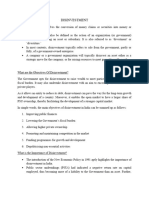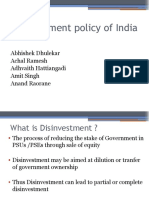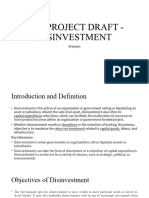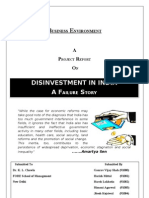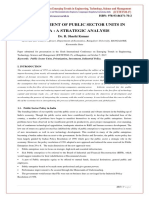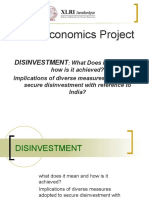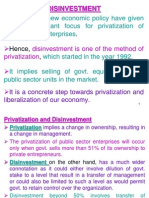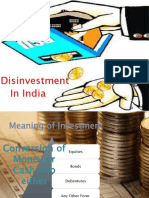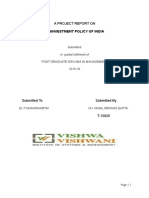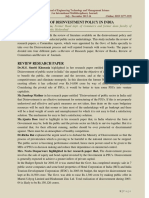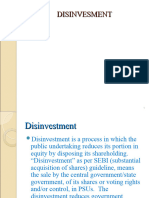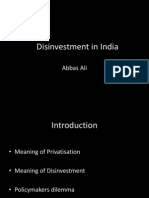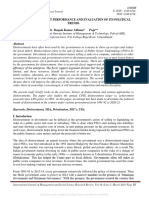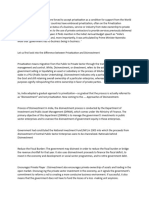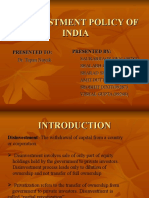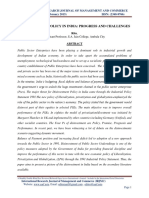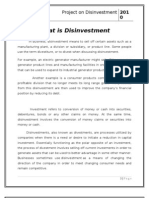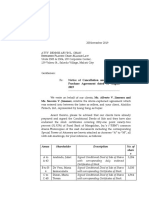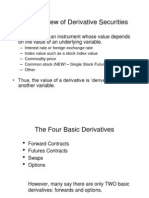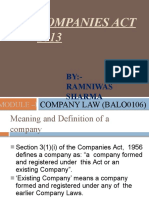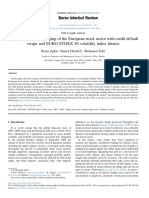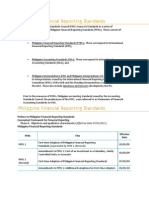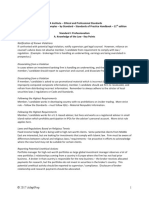Scribd Upload a Document Search Documents Explore
NarwadeBaswant
inShare
Embed Doc Copy Link Readcast Collections Comments
Download
Disinvestme nt in India:
�A Failure Story
The basic objective of starting Public Sector in India was to build infrastructure and
�rapideconomic growth. However, a number of problems such as low productivity, over-manningand other economic
�compulsions like deterioration of balance of payment position andincreasing fiscal deficit led to the adoption of new approach
�toward the public sector in 1991.
B
ACKGROUND
:
1.L
OW
�RODUCTIVITY OF INVESTMENT
From 1950-51 to 1980-81, Indias growth rate was roughly constant
�but savings andinvestment rate more than doubled. From the table it can be seen that it was becauseof low productivity that
�Indias growth was slow.Investment and Savings as a percentage of GDP
Y e a r 1 9 5 0 - 5 1 1 9 6 0 6 1 1 9 7 0 -
�7 1 1 9 8 0 8 1 1 9 8 9 9 0 Investment(Cu rrent Prices,% GDP) 1 0 . 2 1 5 . 7 1 6 . 6 2 2 . 7 2 4 . 1
�Investment(Constan t 1980-81 prices,%GDP) 1 4 . 7 1 8 . 1 1 8 . 7 2 2 . 7 2 1 . 8 Domestic Savings(Current Prices, %GDP)
�1 0 . 4 1 2 . 7 1 5 . 7 2 1 . 2 21.7Source: Disinvestment in India, Sudhir Naib
2.F
ISCAL
S
ITUATION
�IN
1980
During 1980s the fiscal situation deteriorated rapidly. This
�was largely due to anescalation of current expenditure of the government. The table below gives theconsolidated
�Central and state government revenue, expenditure and deficit over the period 196061 to 1980-81, divided into five
�year averages and expressed as percentage of GDP.Consolidate d finances of Central and state Government,
�1960-61 to 198990 F M G 1 8 B , G R O U P I V P a
�g 2
e 3
��Disinvestme nt in India: A Failure Story
Y e a r 1 9 6 0 - 6 1 to1964651965-66 to1969-
�701970-71to 1974751975-76to 1979801980-81to 1984851985-86to 198990Revenue 1 2 . 7 1 3 . 4 1 4 . 6 1 7 . 8 1 8 . 1 2 0 . 0
�Current Expenditure 1 1 . 8 1 2 . 9 1 4 . 2 1 6 . 3 1 8 . 6 2 3 . 0 Current RevenueBalance 0 . 9 0 . 5 0 . 4 1
�. 5 ( 0 . 5 ) ( 2 . 9 ) Capital Expenditure 6 . 6 6 . 0 5 . 1 6 . 9 7 . 5 7 . 1
�Total Expenditure 1 8 . 4 1 8 . 9 1 9 . 3 2 3 . 2 2 6 . 1 3 0 . 0 Fiscal Deficit 5 . 7 5 . 5 4 . 7 5
�. 4 8 . 0 1 0 . 0 Primary FiscalDeficit 5 . 3 5 . 2 4 . 2 4 . 7 6 . 8 7 . 5 Source:
�Disinvestment in India, Sudhir Naib
3.
F
ISCAL
D
EFICIT OF
�THE
C
ENTRAL
G
OVERNMENT
The fiscal deficit of the central govt rose consistently
�from 4% in mid 1970s to 8% of GDPin 198586.Fiscal Deficit of Government 1975-76 to 199091
YearFiscalDeficitBu dgetDeficitPrimary
�DeficitRevenueDefi citMonetisedDeficit 1975-76 4 . 1 0 . 5 2 . 5 1 . 1 0 . 0 1980-81
�6 . . 8 3 1 2 . 1981-82 5 . . 9 4 0 2 .
2 4 . 6 4 3 . 0
1 . 5
0 . 2
�1982-83 6 . . 9 8 0 1 . 1983-84 6 . . 7
0 3 . 9 3 4
0 . 7
0 .
�0 1 1 . 1984-85 7 . . 6 0 1 2 . 1985-86
. 9 5 5 . 6
1 . 8
�8 . . 0 5 2 2 . 1986-87 9 . . 8 8 2 2 .
3 5 . 4 0 5 . 4
2 . 2
2 . 7
�1987-88 8 . . 7 7 2 2 . 1988-89 7 . . 4
1 4 . 0 8 4
1 . 7
1 .
�2 2 1 . 1989-90 7 . . 3 9 2 3 . 1990-91
. 6 8 3 . 1
2 . 6
�8 . 4 2 . 1 4 . 4 3 . 5 2 . 8 Sourc e: Economic Survey, 1992-93, Government of India
�A significant factor was governments non-plan expenditure and an inefficient interest payment system.
�Again the gulf war of 1990 brought the nation to the brink of international debt.
There were huge net outflows of
�NRI deposits from October 1990 and continued tillmid 1991. F M G 1 8 B ,
�G R O U P I V P a g e 2 4
��Disinvestme nt in India: A Failure Story
RBI adopted sharp
�contractionary measures and had taken huge amounts fromInternationa l Monetary Fund in July, 1990 and January, 1991
�amounting to $2.4 billion.
Foreign Exchange Reserves were reduces $ 1 Billion which could support
�only twoweeks imports.
Inflation was staring at 14%
On July6, 1991 47 tons of gold were transferred from RBI to
�Bank of England,London. Already 20 tons of gold were sold in International market through StateBank of
�India.When India turned to IMF and World Bank for further support, they showed concerns over returns on State owned
�enterprises and budgetary support provided to them. It was then adecision was taken in July, 1991 to bring about
�macroeconomic stabilisation and structuralreforms of industrial and trade policy.
T
IMELINE
�In February, 1991 the Department of Economic Affairs submitted a paper to CabinetCommitt
�ee on Political Affairs (CCPA) to approve the government intentions to disinvest upto 20% of its equity in selected public
�sector undertakings.The disinvestment announcement was made on 4March, 1991 during the interim
�budgetsession for 1991-92 under the Chandrashekhar government. The Policy of disinvestment hasevolved over
�the years. This period can be broadly divided into 4 phases.
The first phase being 1991-92 to 1995-96 where partial
�disinvestment was taken in piecemeal manner.
Second Phase 1996-97 to 1997-98, an effort to
�institutionalize the disinvestment pr ocess was undertaken on a firm footing by constituting the
�DisinvestmentC ommission.
The third Phase 198-98-99 to 2007-08 where Department of Disinvestment (Now aMinistry)
�and National investment fund was formed to look after the disinvestment pro cess and the funds generated from it.
�F M G 1 8 B , G R O U P I V P a g e 2 5
��Disinvestme nt in India: A Failure Story
Fourth phase, the Current one
�where government is planning to sell its stake in NTPCL, SJVNL, RECL and NMDCL.
�PHASE 1 (1991-92
TO
1995-96):
Phase one Started when Chandrashekhar government,
�while presenting the interim budget for the year 1991-92 declared disinvestment up to 20%.The objective was to
�broad-base equity,improve management, enhance availability of resources for these PSEs and yield
�resourcesfor exchequer.
I
NDUSTRIES
R
ESERVED FOR
�UBLIC SECTOR PRIOR TO
1991
1.
�Arms and Ammunition and allied items of defence equipment.2.Ato mic energy.3.Iron and
�steel.4.Heavy castings and forgings of iron and steel.5.Heavy plant and machinery required for iron
�and steel production, for mining.6.Heavy electrical plants.7.Coal and lignite.8.Minera ls oils.9.Mining
�of iron ore, manganese ore, chrome ore, gypsum.10.Mini ng and processing copper, lead, zinc,
�tin.11.Minerals specified in the Schedule to the Atomic Energy.12.Aircra ft.13.Air transport.14.Rail
�transport.15.Ship building. 16. Telephones, Telephone cables, Telegraph and Wireless apparatus
�(excluding radioreceiving sets). F M G 1 8 B , G R O U P I V P a
�g 2
e 6
��Disinvestme nt in India: A Failure Story
17.Generation and distribution of electricity.The
�Industrial Policy Statement of 24th July 1991 stated that the government would divest part of its holdings in
�selected PSEs, but did not place any cap on the extent of disinvestment. Nor did it restrict disinvestment in favour of any
�particular class of investors.During this Phase the sole was to generate revenue without following
�any objective seriously.
I
NDUSTRIES
R
ESERVED FOR
�UBLIC SECTOR AFTER
J
ULY
, 1991
�1.Arms and Ammunition and allied items of defence equipment, aircraft and warship.2.Atomi c Energy.3.Coal
�and Lignite.4.Miner al Oils.5.Mining of iron ore, manganese ore, chrome ore, gypsum, sulphur, gold and
�diamond.6.Minin g of copper, lead, zinc, tin, molybdenum and wolfram. 7. Minerals specified in the
�schedule to Atomic Energy Order, 1953.8.Railway Transport.
R
ANGARAJAN
C
OMMITTEE
�1992-1993
The government reconstituted the committee which it formed in February 1992 toinstitutionalize
�the disinvestment process. The committee included Dr. C. Rangarajan, thethen Member Planning commission as
�chairman and Dr. Y. Venugopal Reddy as Member Secretar y. The committee gave its report on April, 1993. The Highlights of the
�committeereport are as follows:1. 49% of equity could be divested for industries explicitly reserved for the public sector 2. In
�exceptional cases the public ownership level could be kept at26%.3. In all other cases it recommended 100 per cent
�divestment of Government stake.4. Holding 51% or more equity by the Government was recommended only for six
�Scheduleindustrie s, namely:
Coal and lignite
Mineral oils
Arms, ammunition and
�defence equipment F M G 1 8 B , G R O U P I V P a
�g 2
e 7
��Disinvestme nt in India: A Failure Story
Atomic energy
�Radioactive minerals
Railway transport
D
ISINVESTMENT IN
1991-92:
�A steering Committee was formed for selection of PSEs for disinvestments. The Departmentof
�Public Enterprises (DPE) coordinated all activities under the Ministry of Industry.
A
)F
IRST
�T
RANCHE OF
D
ISINVESTMENT
(D
ECEMBER
, 1991):
�Out of 244 public enterprises 41 were selected, but 10 were dropped on the grounds of beingconsultancy firms, negative
�asset value or they incurred losses in previous financial year. TheRemaining 31 were grouped into 3 categories Very Good,
�Good and Average on the basis of net assets value per share vis-a-vis face value of Rs10 as on March,1991. The
�totalvalue of equity in each basket was Rs50 million.Bids were invited from 10 financial institutions/
�mutual funds which consisted of 825 bundles each consisting of 9 PSEs. A total of 710 bids for 533 bundles were received
�from 9mutual funds/ institutions and 406 bundles for a total value of Rs14.2billion were sold. UnitTrust of
�India was the major purchaser accounting for Rs. 7.75 billion of the sale.
B
)S
ECOND
�RANCHE OF
D
ISINVESTMENT
(F
EBRUARY
, 1992): In second tranche DPE
�asked ICICI to evaluate and advice issue price equity of selectedPSEs. A List of 16 PSEs was prepared and shares were
�grouped into 120 bundles as before.The reserve price fixed per bundle was Rs 10.08 crore. Bids were invited from 36
�institutionsand banks. A total of Rs. 1611 crore were realised with Unit Trust of India again being themajor purchaser. The
�Shares of Metal Scrap Trading Corporation remained unsold.Details of the PSEs Divested in 199192
�Name of the EnterpriseNo. Of Shares(incrore)% of Disinvestment A n d r e w Y u l e ( A Y ) 0 . 1 0 1
�5 9 . 6 0 B h a r a t E a r t h M o v e r s L t d . ( B E M L ) 0 . 6 0 0 0 2 0 . 0 0
�F M G 1 8 B , G R O U P I V P a g e 2 8
��Leave a Comment
Submit Characters: 400
Disinvestment in India
Download or Print 8,406 Reads Uploaded by jitesh_iem TIP Press Ctrl-F to quickly search anywhere in the document.
27 p. white_paper_c11-520862
58 p. Tender Document
7 p. DLM Assigmnet_JITESH_KEJRIWAL
�Upload a Document Search Documents
Follow Us! scribd.com/scribd twitter.com/scribd facebook.com/scribd About Press Blog Partners Scribd 101 Web Stuff Support FAQ Developers / API Jobs Terms Copyright Privacy
Copyright 2012 Scribd Inc. Language: English
